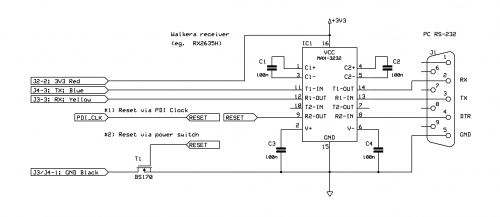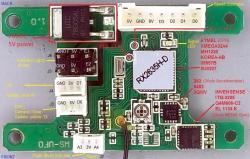Walkera UP02 software clone: UP42
Monday, June 22, 2015
UP42 - A Walkera UP02 Quadcopter firmware flasher clone
UP42 is a multi platform (Windows 32/64, Linux 32/64) command line utility with the following features:
- Walkera firmware en-/decryption
- Serial port DTR can be used to force receiver into boot loader mode
- Configurable profiles in simple ‘.ini’ file style config file
- fast
This post is part of a series
- Flashing new Firmware to Walkera RX/TX without UP02
- Decrypting receiver firmware
- Walkera receiver components
- Hello World firmware for the RX2635H board
- Serial port and external 16MHz oscillator
- Using the ITG-3205 mems gyro
- Walkera UP02 software clone: UP42 (this post)
- Walkera RX2635H as generic development board?
- Walkera USB port
- Walkera + Arduino = Walkino
Command line usage
The UP42 flasher understands these command line arguments:
-h,–help
Show help/usage informations.
-V,–version
Displays version information.
-v,–verbose
Enables verbose mode. If used multiple times (e.g. -v -v -v or -vvv) different debug informations will be shown.
-c,–config
Specifies which config file to use. Defaults to *binary*.ini. If binary is named up42, up42.ini is used as default config file name.
-I,–info
Connects to a Walkera receiver board and displays it’s information string. Does not flash firmware.
-P,–profile
Defines which profile should be used from the config file.
-q,–quiet
Be quiet. Dont output any messages except data.
-i,–input
Input file to send. If ‘-’ stdin will be used.
-o,–output
Output file after encryption with key. If ‘-’ stdout will be used. If no key specified outputFile == inputFile. If no output file is specified and a key is present a temporary output file is created which is deleted after flashing.
-k,–key
Key to XOR-encrypt inputFile with. Can be either:
- a hex string starting with ‘0x’
- the name of a file which content is used as key
- if not hex or file the character string itself
If omitted no encryption is performed on input file.
-p,–port
Name of the serial port to send the encrypted output file via XModem to. If omitted nothing will be sent.
-b,–baud
Baude rate to use. Defaults to 9600.
-1,-2
1 or 2 stop bits.
-7,-8
7 or 8 data bits.
-N,-E,-O
No, Even or Odd parity.
-D,–nodtr
Disable DTR control.
Configuration
A UP42 config file is a simple ‘.ini’ file where each section represents a so called profile.
This is a sample file for two Walkera receiver models. A Hoten-X RX2635H and a QR-Ladybird RX2634H:
[RX2635H] name=RX2635H description=Walkera Hoten-X key=0×8E500166526E7BD7EEC85C7AC05AD792 input=MyFirmware.bin output=MyFirmware.fw port=COM1 ; Walkera normally uses 38400,N,8,1 baud baud=38400 ; 7 or 8 data bits dataBits=8 ; 0=one stopbit, 1=one and a half stop bit, 2=two stopbits stopBits=0 ; 0=no, 1=odd, 2=even, 3=mark, 4=space parity=0 [RX2634H] name=RX2634H description=Walkera QR-LadyBird key=0xD0943F8C297615D82040E32745D848AD
In this sample the profile RX2635H defines values for the command line parameters
(in order) -k, -i, -o, -p, -b, -8, -N.
So you can simply call
up42 -P RX2635H
to:
- encrypt the file MyFirmware.bin with the key 0×8E500166526E7BD7EEC85C7AC05AD792
- write the encrypted content to file MyFirmware.fw
- flash the receiver using XMODEM via port COM1, 38400 baud, no parity, 8 databits and 1 stopbit
After flashing the receiver the bootloader mode is ended and the new firmware is started.
Compiling
The latest source code for UP42 can be found on GitHub.
Windows
Building on Windows can be done in two ways:
- building with TCC (Tiny C compiler)
If you dont have Visual Studio available or dont want install it wasting some gigabytes of disk space, UP42 can be compiled using TCC from http://bellard.org/tcc/. Download and install the 32 or 64 bit version and change the build.cmd file with the path to TCC. You will also need GNU make for Windows from http://gnuwin32.sour … et/packages/make.htm - building using Microsoft Visual Studio.
For building UP42 with Visual Studio there is a solution file (.sln) included. Open it with Visual Studio and compile it either for 32 or 64 bit.
Prebuilt Windows binaries are available:
Linux
To build under Linux you can use the included
build.sh
shell script which uses make and gcc.
Connecting the board / the flash cable
UP42 needs a serial connection to the receiver board. Walkera receivers work with low voltage (3.3V) wheras a PC serial port uses 12 Volts. So directly connecting the receiver to the PC is not a good idea. A level shifter like the MAX3232 from Maxim must be used.
Such a cable was already shown in another post. UP42 can be used with this cable but you have to manually enter bootloader mode by reseting (powering on) the receiver while UP42 waits for the board to become ready (about ~ 10 seconds).
This can be automated by using the serial port DTR line to reset the board during the wait time. Thus making firmware updates completely automatic. For this to work the following modified cable must be used.
Board reset can be performed in two ways:
- by connecting the DTR reset to PDI_CLK
- or by using a FET transistor to toggle power and thus reseting the board
Only use one method. If you use method #1 leave out T1 and make a straight GND connection. When using method #2 just leave PDI_CLK unconnected.
Usage
UP42 can be used to:
- flash firmware to the receiver
- identify a receiver
- XOR encrypt or decrypt receiver firmware
If at least an input file, a key and a port is specified UP42 tries first to encrypt the input file with the given key and then flashes the encrypted firmware to the board. If no key is specified then the input file is flashed without encryption. This is usefull when flashing original Walkera firmware files which are already encrypted. If an input, and output file and a key is given but no port only an encryption is done. As XOR encryption is symetric this can also be used to decrypt (e.g. original Walkera firmware) files by using the encrypted file as input. When the -I (–info) parameter is used no encryption or flashing is done. Instead UP42 tries to connect to the board and will display it’s ID string on the console.

